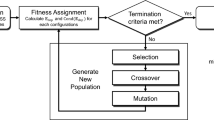Abstract
The aim of this research is to develop a model for the direct detection three-dimensional (3-D) imaging LADAR system using Quantum Well Infrared Photodetector (QWIP) Focal Plane Array (FPA). This model is employed to study how to add 3-D imaging capability to the existing conventional thermal imaging systems of the same basic form which is sensitive to 3–5 µm(mid-wavelength infrared, MWIR) or 8–12 µm (long-wavelength infrared, LWIR) spectral bands. The integrated signal photoelectrons in case of short integration time is required to transmit laser pulses with higher energy in order to obtain photoelectrons nearest those values obtained from the background photoelectrons in thermal imaging system with the longer interval of time. Since the operating conditions of the proposed system are of low levels for speckle diversity and high levels of signal photoelectrons, it was shown that the signal obeys the Gaussian probability density function. The evaluation of system performance of the proposed model shows that it needs a detector with low dark current and high transmitted energy to obtain satisfactory parameter values.
Similar content being viewed by others
References
S. D. Gunapala, S. V. Bandara, J. K. Liu, J. M. Mumolo, C. J. Hill, S. B. Rafol, D. Salazar, J. Woolaway, P. D. LeVan, M. Z. Tidrow, “Towards dualband megapixel QWIP focal plane arrays,” Infrared Physics & Technology 50, No. 2–3, 217 (2007), DOI: 10.1016/j.infrared.2006.10.005.
Arnold C. Goldberg, Theodore Fischer, Stephen W. Kennerly, Samuel C. H. Wang, Mani Sundaram, Parvez N. Uppal, Michael L. Winn, Gregory L. Milne, Mark A. Stevens, “Dual-band QWIP MWIR/LWIR focal plane array test results,” Proc. SPIE 4028, 276 (2000), DOI: 10.1117/12.391740.
Wei Lu, Li Ling, Honglou Zheng, Wenlan Xu, DaYuan Xiong, “Development of an infrared detector: Quantum well infrared photodetector,” Science in China Series G: Physics, Mechanics and Astronomy 52, No. 7, 969 (Jul. 2009), DOI: 10.1007/s11433-009-0131-0.
H. C. Liu, R. Dudek, A. Shen, E. Dupont, C. Y. Song, Z. R. Wasilewski, M. Buchanan, “High absorption (>90%) quantum-well infrared photodetectors,” Appl. Phys. Lett. 79, No. 25, 4237 (2001), DOI: 10.1063/1.1425066.
Marius A. Albota, Richard M. Heinrichs, David G. Kocher, Daniel G. Fouche, Brian E. Player, Michael E. O’Brien, Brian F. Aull, John J. Zayhowski, James Mooney, Berton C. Willard, Robert R. Carlson, “Three-dimensional imaging laser radar with a photon-counting avalanche photodiode array and microchip laser,” Appl. Optics 41, No. 36, 7671 (2002), DOI: 10.1364/AO.41.007671.
Jeff Beck, Milton Woodall, Richard Scritchfield, Martha Ohlson, Lewis Wood, Pradip Mitra, Jim Robinson, “Gated IR imaging with 128x128 HgCdTe electron avalanche photodiode FPA,” Proc. SPIE 6542, 654217 (2007), DOI: 10.1117/12.719358.
C. Kumar N. Patel, “From CO2 lasers to quantum cascade lasers—A saga of high power infrared lasers,” J. Laser Appl. 21, No. 4, 224 (2009), DOI: 10.2351/1.3263623.
Manijeh Razeghi, Steven Slivken, Yanbo Bai, Burc Gokden, Shaban Ramezani Darvish, “High power quantum cascade lasers,” New J. Phys. 11, No. 12, 125017 (2009), DOI: 10.1088/1367-2630/11/12/125017.
Richard Maulini, Arkadiy Lyakh, Alexei Tsekoun, Rowel Go, Christian Pflügl, Laurent Diehl, Federico Capasso, C. Kumar N. Patel, “High power thermoelectrically cooled and uncooled quantum cascade lasers with optimized reflectivity facet coatings,” Appl. Phys. Lett. 95, No. 15, 151112 (2009), DOI: 10.1063/1.3246799.
Jae Su Yu, Steven Slivken, Allan J. Evans, Manijeh Razeghi, “High-performance continuous-wave operation of ~4.6 μm quantum-cascade lasers above room temperature,” IEEE J. Quantum Electron. 44, No. 8, 747 (Aug. 2008), DOI: 10.1109/JQE.2008.924434.
Benjamin G. Lee, Haifei A. Zhang, Christian Pflügl, Laurent Diehl, Mikhail A. Belkin, Milan Fischer, Andreas Wittmann, Jerome Faist, Federico Capasso, “Broadband distributed-feedback quantum cascade laser array operating from 8.0 to 9.8 m,” IEEE Photonics Technol. Lett. 21, No. 13, 914 (Jul. 2009), DOI: 10.1109/LPT. 2009.2020440.
V. D. Shadrin, V. V. Mitin, V. A. Kochelapb, K. K. Choi, “Photoconductive gain and generation-recombination noise in quantum well infrared photodetectors,” J. Appl. Phys. 77, No. 4, 1771 (1995), DOI: 10.1063/1.358873.
N. Snapi, Y. Paltiel, A. Zussman, G. Jung, A. Ben Simon, “Non-Gaussian noise in quantum wells infrared photodetectors,” Infrared Physics & Technology 50, No. 2–3, 100 (Apr. 2007), DOI: 10.1016/j.infrared.2006. 10.012.
N. E. I. Etteh, Paul Harrison, “Carrier scattering approach to the origins of dark current in mid and far-infrared (terahertz) quantum-well intersubband photodetectors (QWIPs),” IEEE J. Quantum Electron. 37, No. 5, 672 (May 2001), DOI: 10.1109/3.918580.
N. E. I. Etteh, P. Harrison, “Quantum mechanical scattering investigation of the thermionic and field induced emission components of the dark current in quantum well infrared photodetectors,” J. Appl. Phys. 92, No. 1, 248 (2002), DOI: 10.1063/1.1481214.
Shahram Mohammad Nejad, M. Pourmahyabadi, A. Amidian, “Optimal dark current reduction in quantum well 9 µm GaAs/AlGaAs infrared photodetectors with improved detectivity,” Proc. of 13th IEEE Int. Conf. on Electronics, Circuits and Systems, ICECS, 10–13 Dec. 2006, Nice (IEEE, 2006), pp. 918–921, DOI: 10.1109/ICECS.2006.379939.
G. Stephen Mecherle, “Signal speckle effects on optical detection with additive Gaussian noise,” JOSA A 1, No. 1, 68 (1984), DOI: 10.1364/JOSAA.1.000068.
Douglas G. Youmans, “Avalanche photodiode detection statistics for direct detection laser radar,” Proc. SPIE 1633, 41 (1992), DOI: 10.1117/12.59115.
H. T. Yura, “LADAR detection statistics in the presence of pointing errors,” Appl. Optics 33, No. 27, 6482 (1994), DOI: 10.1364/AO.33.006482.
Markus Henriksson, “Detection probabilities for photon-counting avalanche photodiodes applied to a laser radar system,” Appl. Optics 44, No. 24, 5140 (2005), DOI: 10.1364/AO.44.005140.
J. W. Goodman, Statistical Optics (Wiley, New York, 1985).
Gregory R. Osche, Optical Detection Theory for Laser Applications (Wiley, New Jersy, 2002).
Alan Jeffrey, Daniel Zwillinger, Table of Integrals, Series, and Products, 7th ed. (Academic Press, 2007).
Sanjay Krishna, Oh-Hyun Kwon, Majeed M. Hayat, “Theoretical investigation of quantum-dot avalanche photodiodes for mid-infrared applications,” IEEE J. Quantum Electron. 41, No. 12, 1468 (Dec. 2005), DOI: 10.1109/JQE.2005.858791.
Author information
Authors and Affiliations
Corresponding author
Additional information
Original Russian Text © M. B. El Mashade, A.E. AbouElez, 2016, published in Izv. Vyssh. Uchebn. Zaved., Radioelektron., 2016, Vol. 59, No. 5, pp. 3–19.
About this article
Cite this article
El Mashade, M.B., AbouElez, A.E. QWIP focal plane array theoretical model of 3-D imaging LADAR system. Radioelectron.Commun.Syst. 59, 195–206 (2016). https://doi.org/10.3103/S0735272716050010
Revised:
Published:
Issue Date:
DOI: https://doi.org/10.3103/S0735272716050010




